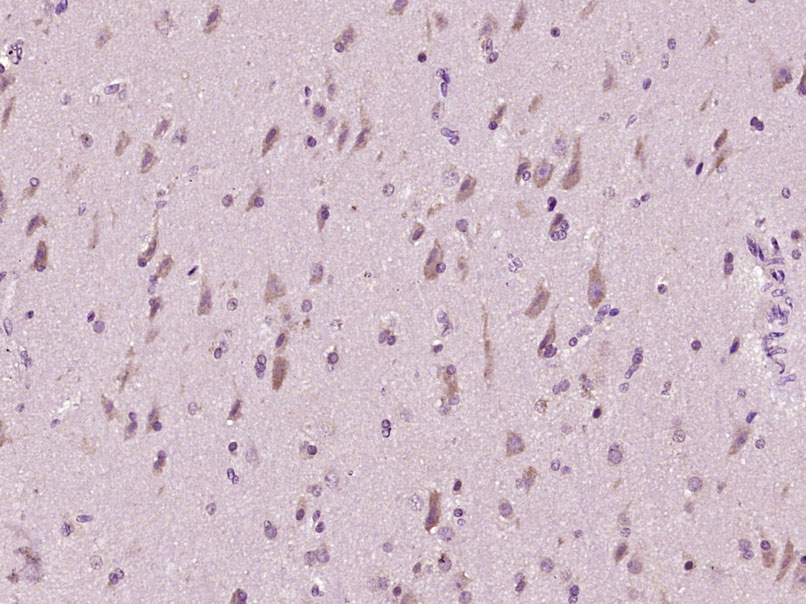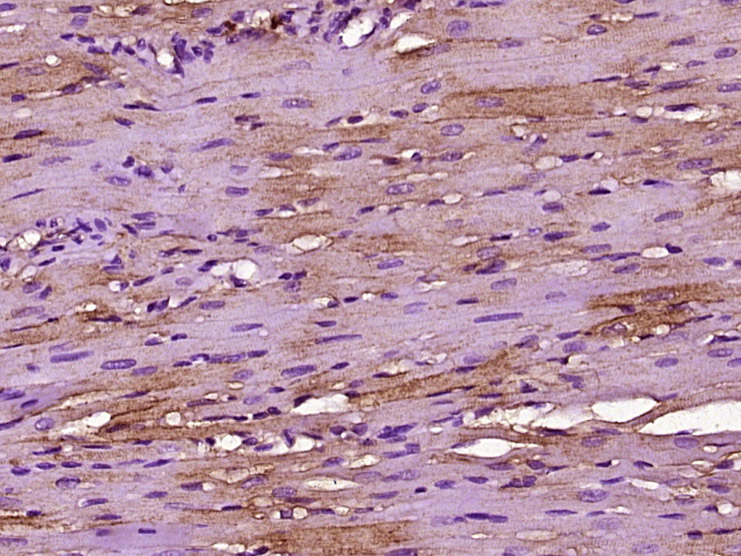
Rabbit Anti-Caveolin-3 antibody
CAV 3; CAV3; Caveolin3; Caveolin 3; LGMD1C; M caveolin; VIP 21; VIP21; AI385751; Cav-3; caveolin-3; M-cav; M-caveolin; CAV3_MOUSE.
View History [Clear]
Details
Product Name Caveolin-3 Chinese Name 细胞质膜微囊蛋白-3抗体 Alias CAV 3; CAV3; Caveolin3; Caveolin 3; LGMD1C; M caveolin; VIP 21; VIP21; AI385751; Cav-3; caveolin-3; M-cav; M-caveolin; CAV3_MOUSE. Research Area Tumour Cell biology immunology Signal transduction Apoptosis transcriptional regulatory factor Immunogen Species Rabbit Clonality Polyclonal React Species Human, Rat, (predicted: Mouse, Dog, Pig, Cow, Horse, Rabbit, Sheep, ) Applications ELISA=1:5000-10000 IHC-P=1:100-500 IHC-F=1:100-500 ICC=1:100-500 IF=1:100-500 (Paraffin sections need antigen repair)
not yet tested in other applications.
optimal dilutions/concentrations should be determined by the end user.Theoretical molecular weight 17kDa Cellular localization cytoplasmic Form Liquid Concentration 1mg/ml immunogen KLH conjugated synthetic peptide derived from human Caveolin-3 : 1-80/151 Lsotype IgG Purification affinity purified by Protein A Buffer Solution 0.01M TBS(pH7.4) with 1% BSA, 0.03% Proclin300 and 50% Glycerol. Storage Shipped at 4℃. Store at -20 °C for one year. Avoid repeated freeze/thaw cycles. Attention This product as supplied is intended for research use only, not for use in human, therapeutic or diagnostic applications. PubMed PubMed Product Detail Caveolae are specialized domains of the plasma membrane that are implicated in the sequestration of a variety of lipid and protein molecules. It has been suggested that these important cellular organelles have a pivotal role in such diverse biochemical processes as lipid metabolism, growth regulation, signal transduction, and apoptosis. Caveolin interacts with and regulates heterotrimeric G-proteins. Currently, there are three members of the caveolin multigene family which are integral membrane proteins that comprise the major structural component of the caveolar membrane in vivo. Caveolin-2 protein is abundantly expressed in fibroblasts and differentiated adipocytes, smooth and skeletal muscle, and endothelial cells. The expression of caveolin-1 is similar to that of caveolin-2 while caveolin-3 expression appears to be limited to muscle tissue types.
Function:
May act as a scaffolding protein within caveolar membranes. Interacts directly with G-protein alpha subunits and can functionally regulate their activity. May also regulate voltage-gated potassium channels. Plays a role in the sarcolemma repair mechanism of both skeletal muscle and cardiomyocytes that permits rapid resealing of membranes disrupted by mechanical stress.
Subunit:
Homooligomer (By similarity). Interacts with DYSF. Interacts with DLG1 and KCNA5; forms a ternary complex. Interacts with DAG1 (via its C-terminal); the interaction prevents binding of DAG1 with DMD (By similarity). Interacts with TRIM72. Interacts with MUSK; may regulate MUSK signaling.
Subcellular Location:
Golgi apparatus membrane; Peripheral membrane protein (By similarity). Cell membrane; Peripheral membrane protein (By similarity). Membrane, caveola; Peripheral membrane protein (By similarity). Note=Potential hairpin-like structure in the membrane. Membrane protein of caveolae (By similarity).
Tissue Specificity:
Expressed predominantly in muscle.
Post-translational modifications:
Sumoylation with SUMO3 by PIAS4 may reduce agonist-induced internalization and desensitization of adrenergic receptor ABRD2 (By similarity).
Similarity:
Belongs to the caveolin family.
SWISS:
P56539
Gene ID:
859
Database links:Entrez Gene: 859 Human
Entrez Gene: 12391 Mouse
Omim: 601253 Human
SwissProt: P56539 Human
SwissProt: P51637 Mouse
Unigene: 98303 Human
Unigene: 3924 Mouse
Unigene: 98191 Rat
Product Picture
Partial purchase records(bought amounts latest0)
No one bought this product
User Comment(Total0User Comment Num)
- No comment




 +86 571 56623320
+86 571 56623320




